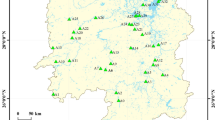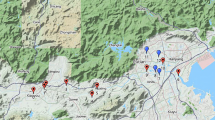Abstract
The analysis and prediction of water quality are of great significance to water quality management and pollution control. In general, current water quality prediction methods are often aimed at single indicator, while the prediction effect is not ideal for multivariate water quality data. At the same time, there may be some correlations between multiple indicators which the conventional prediction models cannot capture. To resolve these problems, this paper proposes a deep learning model: Graph Convolutional Network with Feature and Temporal Attention (FTGCN), realizing the prediction for multivariable water quality data. Firstly, a feature attention mechanism based on multi-head self-attention is designed to capture the potential correlations between water indicators. Then, a temporal prediction module including temporal convolution and bidirectional GRU with a temporal attention mechanism is designed to deal with temporal dependencies of time series. Moreover, an adaptive graph learning mechanism is introduced to extract hidden associations between water quality indicators. An auto-regression module is also added to solve the disadvantage of non-linear nature of neural networks. Finally, an evolutionary algorithm is adopted to optimize the parameters of the proposed model. Our model is applied on four real-world water quality datasets, compared with other models for multivariate time series forecasting. Experimental results demonstrate that the proposed model has a better performance in water quality prediction than others by two indices.








Similar content being viewed by others
Data availability
All data generated or analyzed during this study are included in this published article.
References
Abobakr Yahya AS, Ahmed AN, Binti Othman F, et al. (2019) Water quality prediction model based support vector machine model for ungauged river catchment under dual scenarios. Water 11(6):1231
Abu-El-Haija S, Perozzi B, Kapoor A et al (2019) Mixhop: Higher-order graph convolutional architectures via sparsified neighborhood mixing. In: International conference on machine learning, PMLR, pp 21–29
Arora S, Keshari AK (2021) Anfis-arima modelling for scheming re-aeration of hydrologically altered rivers. J Hydrol, 126635
Asadollah SBHS, Sharafati A, Motta D, et al. (2021) River water quality index prediction and uncertainty analysis: a comparative study of machine learning models. J Environ Chem Eng 9(1):104,599
Barzegar R, Moghaddam AA, Adamowski J, et al. (2018) Multi-step water quality forecasting using a boosting ensemble multi-wavelet extreme learning machine model. Stoch Env Res Risk Assess 32 (3):799–813
Barzegar R, Aalami MT, Adamowski J (2020) Short-term water quality variable prediction using a hybrid cnn–lstm deep learning model. Stoch Env Res Risk A, 1–19
Batra R, Chen C, Evans TG, et al. (2020) Prediction of water stability of metal–organic frameworks using machine learning. Nature Mach Intell 2(11):704–710
Cao D, Wang Y, Duan J, et al. (2020) Spectral temporal graph neural network for multivariate time-series forecasting. In: Proceedings of the NeurIPS, p 2020
Chen K, Chen H, Zhou C, et al. (2020) Comparative analysis of surface water quality prediction performance and identification of key water parameters using different machine learning models based on big data. Water Res 171:115,454
Gilmer J, Schoenholz SS, Riley PF, et al. (2017) Neural message passing for quantum chemistry. In: International conference on machine learning, PMLR, pp 1263–1272
Imani M, Hasan MM, Bittencourt LF, et al. (2021) A novel machine learning application: Water quality resilience prediction model. Sci Total Environ 768:144,459
Katimon A, Shahid S, Mohsenipour M (2018) Modeling water quality and hydrological variables using arima: a case study of johor river, malaysia. Sustain Water Resour Manag 4(4):991–998
Kipf TN, Welling M (2017) Semi-supervised classification with graph convolutional networks. In: 5th International conference on learning representations
Klicpera J, Bojchevski A, Günnemann S (2019) Predict then propagate: Graph neural networks meet personalized pagerank. In: 7th International conference on learning representations (ICLR)
Lai G, Chang WC, Yang Y et al (2018) Modeling long-and short-term temporal patterns with deep neural networks. In: The 41st International ACM SIGIR conference on research & development in information retrieval, pp 95–104
Li L, Jiang P, Xu H, et al. (2019) Water quality prediction based on recurrent neural network and improved evidence theory: a case study of qiantang river, china. Environ Sci Pollut Res 26(19):19,879–19,896
Li W, Wei Y, An D, et al. (2022) Lstm-tcn: Dissolved oxygen prediction in aquaculture, based on combined model of long short-term memory network and temporal convolutional network. Environ Sci Pollut Res, 1–12
Liang Y, Ke S, Zhang J, et al. (2018) Geoman: Multi-level attention networks for geo-sensory time series prediction. In: Proceedings of the twenty-seventh international joint conference on artificial intelligence, pp 3428–3434
Liu P, Wang J, Sangaiah AK, et al. (2019) Analysis and prediction of water quality using lstm deep neural networks in iot environment. Sustainability 11(7):2058
Lu H, Ma X (2020) Hybrid decision tree-based machine learning models for short-term water quality prediction. Chemosphere 126(249):169
Luong T, Pham H, Manning CD (2015) Effective approaches to attention-based neural machine translation. In: Proceedings of the 2015 conference on empirical methods in natural language processing. Association for Computational Linguistics. Lisbon, Portugal, pp 1412-1421
Noori N, Kalin L, Isik S (2020) Water quality prediction using swat-ann coupled approach. J Hydrol 590:125,220
Rozario A, Devarajan N (2021) Monitoring the quality of water in shrimp ponds and forecasting of dissolved oxygen using fuzzy c means clustering based radial basis function neural networks. J Ambient Intell Humaniz Comput 12(5):4855–4862
Saraiva SV, de Oliveira Carvalho F, Santos CAG, et al. (2021) Daily streamflow forecasting in sobradinho reservoir using machine learning models coupled with wavelet transform and bootstrapping. Appl Soft Comput 102:107,081
Shah MI, Javed MF, Abunama T (2021) Proposed formulation of surface water quality and modelling using gene expression, machine learning, and regression techniques. Environ Sci Pollut Res 28(11):13,202–13,220
Shih SY, Sun FK, Hy L (2019) Temporal pattern attention for multivariate time series forecasting. Mach Learn 108(8):1421–1441
Srivastava RK, Greff K, Schmidhuber J (2015) Highway networks. In: The 32nd international conference on machine learning, deep learning workshop
Than NH, Ly CD, Van Tat P (2021) The performance of classification and forecasting dong nai river water quality for sustainable water resources management using neural network techniques. J Hydrology 596:126,099
Toyungyernsub M, Itkina M, Senanayake R et al (2021) Double-prong convlstm for spatiotemporal occupancy prediction in dynamic environments. In: 2021 IEEE International Conference on Robotics and Automation (ICRA), IEEE, pp 13,931–13,937
Wang H, Song L (2020) Water level prediction of rainwater pipe network using an svm-based machine learning method. Int J Pattern Recognit Artif Intell 34(02):2051,002
Wang J, Jiang Z, Li F, et al. (2021) The prediction of water level based on support vector machine under construction condition of steel sheet pile cofferdam. Concurr Comput Pract Exp 33(5):e6003
Wu Z, Pan S, Long G et al (2020) Connecting the dots: Multivariate time series forecasting with graph neural networks. In: Proceedings of the 26th ACM SIGKDD international conference on knowledge discovery & data mining, pp 753–763
Xingjian S, Chen Z, Wang H et al (2015) Convolutional lstm network: A machine learning approach for precipitation nowcasting. In: Advances in neural information processing systems, pp 802–810
Yang Y, Xiong Q, Wu C, et al. (2021) A study on water quality prediction by a hybrid cnn-lstm model with attention mechanism. Environ Sci Poll Res 28(39):55,129–55,139
Funding
This paper is supported by National Key R&D Program of China (2018YFB1004300).
Author information
Authors and Affiliations
Contributions
The study conception and design, data collection and analysis, guide of experiments and paper revision were performed by Qingjian Ni. The design of model, code implementation, experiments, the first draft of the manuscript and paper revision were performed by Xuehan Cao. Chaoqun Tan commented on previous versions of the manuscript and made suggestions for revision. Wenqiang Peng and Xuying Kang reviewed the paper and made suggestions for revision.
Corresponding author
Ethics declarations
Ethics approval and consent to participate
All authors have read and agreed to the published version of the manuscript.
Consent for publication
All authors have read and agreed to the published version of the manuscript.
Conflict of interest
The authors declare no competing interests.
Additional information
Responsible Editor: Marcus Schulz
Publisher’s note
Springer Nature remains neutral with regard to jurisdictional claims in published maps and institutional affiliations.
Rights and permissions
Springer Nature or its licensor holds exclusive rights to this article under a publishing agreement with the author(s) or other rightsholder(s); author self-archiving of the accepted manuscript version of this article is solely governed by the terms of such publishing agreement and applicable law.
About this article
Cite this article
Ni, Q., Cao, X., Tan, C. et al. An improved graph convolutional network with feature and temporal attention for multivariate water quality prediction. Environ Sci Pollut Res 30, 11516–11529 (2023). https://doi.org/10.1007/s11356-022-22719-0
Received:
Accepted:
Published:
Issue Date:
DOI: https://doi.org/10.1007/s11356-022-22719-0




